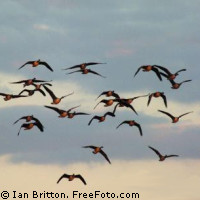Drug resistant bacteria found in Arctic birds
Swedish scientists have discovered drug-resistant bacteria in wild birds living in the high Arctic, far from any human settlement. The findings suggest that antibiotic resistance is now well established in nature. The research, which was partly funded by the EU, is published in the latest edition of the journal Emerging Infectious Diseases. The scientists collected samples of Escherichia coli bacteria from 97 birds in north-eastern Siberia, northern Alaska and northern Greenland during the 2005 'Beringia' expedition, which was organised by the Swedish Polar Research Secretariat. The samples were then cultured on board the expedition ship and tested for resistance to 17 anti-microbial drugs. The analyses revealed resistance to 14 of the 17 drugs tested among the samples. In total eight of the samples displayed drug resistance, and four of these were resistant to four or more drugs. 'We were extremely surprised,' said Björn Olsen, Professor of Infectious Diseases at Uppsala University and at the Laboratory for Zoonosis Research at the University of Kalmar. 'We took samples from birds living far out on the tundra and had no contact with people. This further confirms that resistance to antibiotics has become a global phenomenon and that virtually no region of the Earth, with the possible exception of the Antarctic, is unaffected.' This raises the question of where the drug-resistant bacteria came from. The scientists believe that they were imported by migratory birds. Bird species that spend the winter in up to six different continents can be found in the region around the Bering Strait, the scientists note. Birds could pick up the resistant bacteria at lower latitudes, for example in South-East Asia where there is a lot of antibiotic pressure, and carry them to the Arctic. Previous studies have identified drug-resistant bacteria in wild birds living near human settlements; for example Canada geese in the American state of Maryland were found to be resistant to four antibiotics, and black-headed gulls in the Czech Republic were found to harbour drug-resistant E. coli. 'We already knew that birds in the western world can be carriers of bacteria that are resistant to antibiotics, but it's alarming to find that these bacteria exist among birds out on the tundra,' said Jonas Bonnedahl of the Kalmar County Hospital in Sweden. 'Our findings show that resistance to antibiotics is not limited to society and hospitals but is now spreading into the wild. Escalating resistance to antibiotics over the last few years has crystallised into one of the greatest threats to well-functioning healthcare in the future.' 'We have shown that antimicrobial drug resistance genes are present in one of the most remote areas on Earth,' the researchers conclude. 'This finding highlights the unique nature of bacterial adaptation and the complexity of dissemination of antimicrobial drug resistance. To fully understand the extent of environmental and commensal reservoirs of resistance, studies of antimicrobial drug resistance in different habitats are warranted.'
Countries
Sweden



